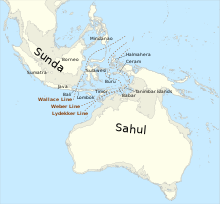
Back خط والاس Arabic Volles xətti Azerbaijani Guét Wallace BAN Linyang Wallace BCL Лінія Уолеса Byelorussian Уолъсова линия Bulgarian ওয়ালেস রেখা Bengali/Bangla Wallaceova linija BS Línia de Wallace Catalan Wallaceova linie Czech

The Wallace line or Wallace's line is a faunal boundary line drawn in 1859 by the British naturalist Alfred Russel Wallace and named by the English biologist T.H. Huxley.
It separates the biogeographical realms of Asia and 'Wallacea', a transitional zone between Asia and Australia also called the Malay Archipelago and the Indo-Australian Archipelago. To the west of the line are found organisms related to Asiatic species; to the east, a mixture of species of Asian and Australian origins is present. Wallace noticed this clear division in both land mammals and birds during his travels through the East Indies in the 19th century.
The line runs through Indonesia, such as Makassar Strait between Borneo and Sulawesi (Celebes), and through the Lombok Strait between Bali and Lombok, where the distance is strikingly small, only about 35 kilometers (22 mi), but enough for a contrast in species present on each island.
The complex biogeography of the Indo-Australian Archipelago is a result of its location at the merging point of four major tectonic plates and other semi-isolated microplates in combination with ancient sea levels. Those caused the isolation of different taxonomic groups on islands at present relatively close to each other. Wallace's line is one of the many boundaries drawn by naturalists and biologists since the mid-1800s intended to delineate constraints on the distribution of the fauna and flora of the archipelago.[1]
- ^ Ali, Jason R.; Heaney, Lawrence R. (June 2021). "Wallace's line, Wallacea , and associated divides and areas: History of a tortuous tangle of ideas and labels". Biological Reviews. 96 (3): 922–942. doi:10.1111/brv.12683. ISSN 1464-7931. PMID 33502095. S2CID 231764849.